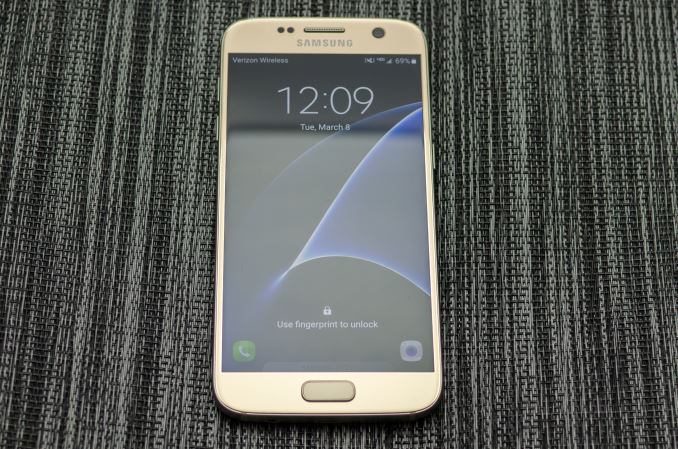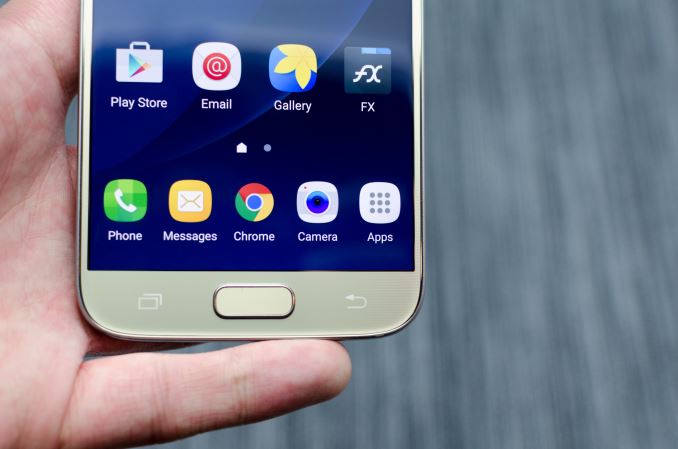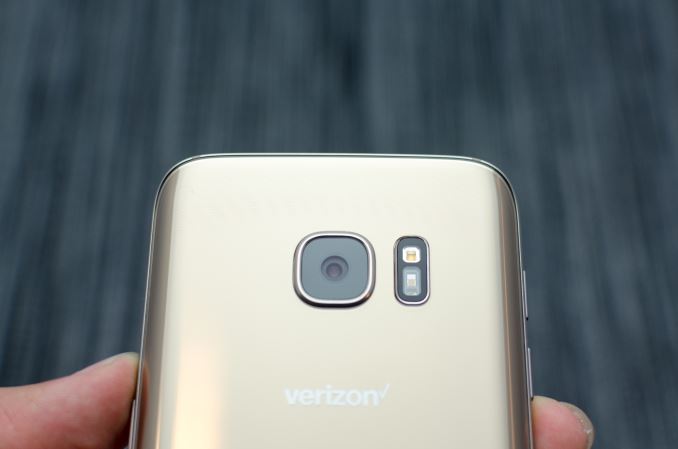The Samsung Galaxy S7 & S7 Edge Review, Part 1
by Joshua Ho on March 8, 2016 9:00 AM ESTInitial Conclusions
Even though we’re just barely scratching the surface of what we can test, the results we already have show quite a bit about the Samsung Galaxy S7. The Galaxy S line remains one of the most popular Android smartphones, and if history is any indication we can get a pretty good idea about what to expect for 2016 just by looking at the Galaxy S7 and S7 edge.
The first place we can start is design, and here we can see that the Galaxy S7 is decidedly an evolution of the Galaxy S6’s ID. However, pretty much every sharp edge has been rounded out to make the device more comfortable in the hand. The device has also been thickened in order to handle the larger battery and reduce the apparent z-height of the camera. The display size of the Galaxy S7 (non-edge) stays at 5.1 inches, and given how long Samsung has stuck to this display size it’s likely that they will be staying at this size for quite some time for their flagship.
In general, it feels like the industry has settled upon a display size somewhere between 5 to 5.5 inches for their flagship devices as going further probably won’t make a lot of sense for ergonomic reasons. I suspect Samsung and many other Android OEMs are settling into an Apple-like 2 year cadence for industrial and material design as replacement cycles lengthen, especially in the United States where subsidized phones have been almost entirely eliminated.
Meanwhile, though we haven’t had the time to run our full suite of battery life benchmarks, the data that we do have is quite interesting. At the very least, it looks like the Galaxy S7 will be a solid upgrade for those coming from the Galaxy S6 and earlier with a 15% bump in battery life or so. Anyone using a phone with an SoC not on a FinFET node will see even bigger gains to battery life, which is impressive to say the least. If you have any device with a Snapdragon 810 or 808 SoC, you’re definitely going to see major gains if you move to any device with a SoC fabricated on a FinFET node.
In terms of SoC performance, the Snapdragon 820 doesn't disappoint. In the time since testing the MDP it seems that between Qualcomm, Samsung, and Google, the trio has finally been able to optimize Snapdragon 820 for Chrome, so performance there is quite acceptable now and a pretty solid uplift over something like the Exynos 7420 or Snapdragon 810. GPU performance is also pretty much right where the Snapdragon 820 MDP was, so performance should be a good step above the A9's GT7600 GPU. Of course, we have yet to consider the power efficiency or sustainability of this performance, but turbo/overdrive performance is always relevant in the mobile space considering just how bursty almost every mobile workload is. It's pretty safe to say that Qualcomm has at least regained their footing in the SoC space, and with future SoCs they may well come to dominate the high end for performance and power once again. For now, it's looking like the race between Exynos 8890, Snapdragon 820, and Kirin 950 will be quite close.
For storage performance, to some extent it seems that the performance gains are relatively small, as the UFS 2.0 storage solutions on the Galaxy S6 and S7 are relatively similar. It’s interesting to see here that despite the now-mandatory use of FDE, the delta in performance between the Galaxy S6 and S7 in storage performance doesn’t seem to exist. This is welcome news as it wasn’t all that long ago that FDE for Android had a noticeable effect on storage performance.
On the display side, again we can see that the Galaxy S7 has a relatively similar display to the Galaxy S6. Calibration should be relatively good across the board, and AMOLED retains all of its traditional advantages including high contrast, support for wide color gamuts, low transition time, and improved power efficiency at lower average picture levels. Peak brightness is the only noticeable area where things seem to change, but I suspect that this will vary noticeably depending upon the unit. The one issue that I continue to notice here is that the edge display on the Galaxy S7 edge has a green tint at the edges, likely due to the diamond PenTile subpixel arrangement.
On the software side, Samsung’s TouchWiz UI continues to be more of the same when compared to the Galaxy Note5. The edge features continue to be somewhat interesting, but I continue to find myself thinking that there would be no difference if the same feature was implemented on the non-edge variant. Thankfully, the lag that I noticed last month in my initial hands-on time with the device seems to just have been a function of pre-release software, as the Galaxy S7 is relatively performant here. Although I’m not sure I’d go as far as to say that the Galaxy S7 is entirely free of lag. I suspect that Samsung has to balance power efficiency and responsiveness to some extent here, as while devices like the Nexus 5 can feel incredibly smooth and responsive there are very real knock-on effects in terms of practical battery life.
I’m also looking forward to testing features like Samsung Pay that are finally being deployed to the extent that I can use my personal credit card with Samsung Pay on my phone. However, out of the box TouchWiz still has some issues with an overly-neon theme, and in general things like Always-On Display already feel like they aren’t quite executed as well as they should be. I also noticed that the fingerprint scanner performance is strongly influenced by initial setup if I didn’t scan some areas on initial setup they never seemed to work very well unless I retrained the finger.
As for making a choice between the Galaxy S7 edge and Galaxy S7, there basically aren't any outside of size for the most part. There is the edge display, but by and large it feels like that's more of an aesthetic choice than a functional one. As we have seen you do get better battery life in the Galaxy S7 edge, but I don't feel like it makes sense to cross-shop the two. If you want one-handed usability, the Galaxy S7 is the only choice that makes sense. If you want a phablet, the Galaxy S7 edge is the only choice that makes sense.
Overall, I think the Galaxy S7 is looking to be one of the better devices of the year. Of course, there’s still a lot more to test, but the initial indications are already looking quite good. If you absolutely want the Galaxy S7 now, I don’t think there will be any major showstoppers present in this phone. However, if you’re looking to buy the best phone possible available this year I think it’s still too early to say where the chips will fall as Samsung's eager competitors have their own flagship phones right around the corner.














202 Comments
View All Comments
Michael Wilding - Tuesday, March 8, 2016 - link
Great write up Josh. I'm looking forward to seeing the camera performance, and the Adreno 530 is a beast! Let's hope performance can be sustained without significant throttling.warreo - Tuesday, March 8, 2016 - link
Yes, somewhat disappointed that overheating wasn't addressed in Part 1 given Andrei's skewering of Samsung's use of a heatpipe and his comments that the S7 got pretty hot under load. Hope it gets addressed in detail for Part 2!Ethos Evoss - Wednesday, March 9, 2016 - link
That is awesome that in EU will have Exynos 8890 .. crappy SD820 battery drainer..Azurael - Thursday, March 10, 2016 - link
I seem to recall that real world battery life has traditionally been worse on Samsung SoCs than Qualcomm's mainly due to the modems using a lot more power - hopefully they've resolved that this generation... Personally, I'm disappointed that we get the Exynos version in Europe because it means there will probably never be a fully working AOSP port.leexgx - Monday, March 14, 2016 - link
be nice to add CUBOT H1 results in there as well (i had the phone for like a month or 2 now and 2 days of active use is lovely without having to use an external battery that norm would still only last me a day on my last phone)my use i am typically getting 8 hours screen on time (i use GPS a lot so i never expect to get the 12 hours screen on time, or probably mythical 15-18 hours if anandtech benched it for power)
leexgx - Monday, March 14, 2016 - link
anandtech review http://www.anandtech.com/show/9868/cubot-h1-smartp...not sure if the phone is fully suitable for USA due to 3G and (real) 4G Bands been used on the phone
Ethos Evoss - Wednesday, March 9, 2016 - link
Huawei Mate 8 rocks .. still !jjj - Friday, March 11, 2016 - link
A throttling result for the Exynos variant of the Edge with a 42% drop http://www.techspot.com/articles-info/1147/images/...MaxIT - Monday, March 14, 2016 - link
... as usual. Samsung and Qualcomm just can't balance their system. They just look for a benchmark number to impress people and try to be competitive with Apple. But that's just a smoke curtain...jjj - Wednesday, March 9, 2016 - link
There is finally a GFXBench long term perf result for the MI5 https://gfxbench.com/device.jsp?benchmark=gfx40&am...There are some complications though, the device is just 1080p, the 60FPS limit,no heatpipe. While keeping all that in mind, we do see a 37% drop and this test is not the worst case scenario. Hopefully Andrei will have a better test based on OpenGL ES 3.x or test it with some actual games since T-Rex is becoming outdated.